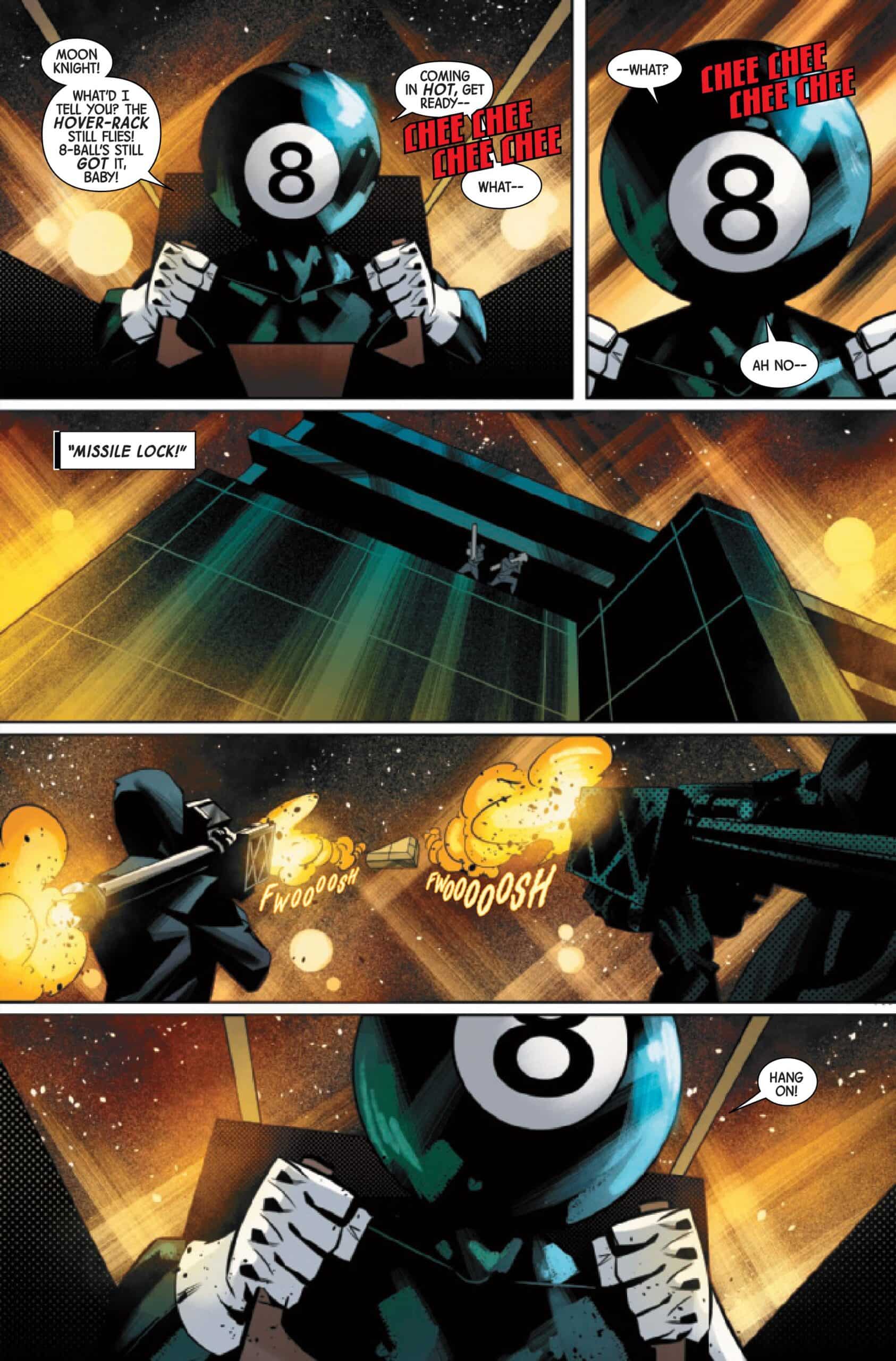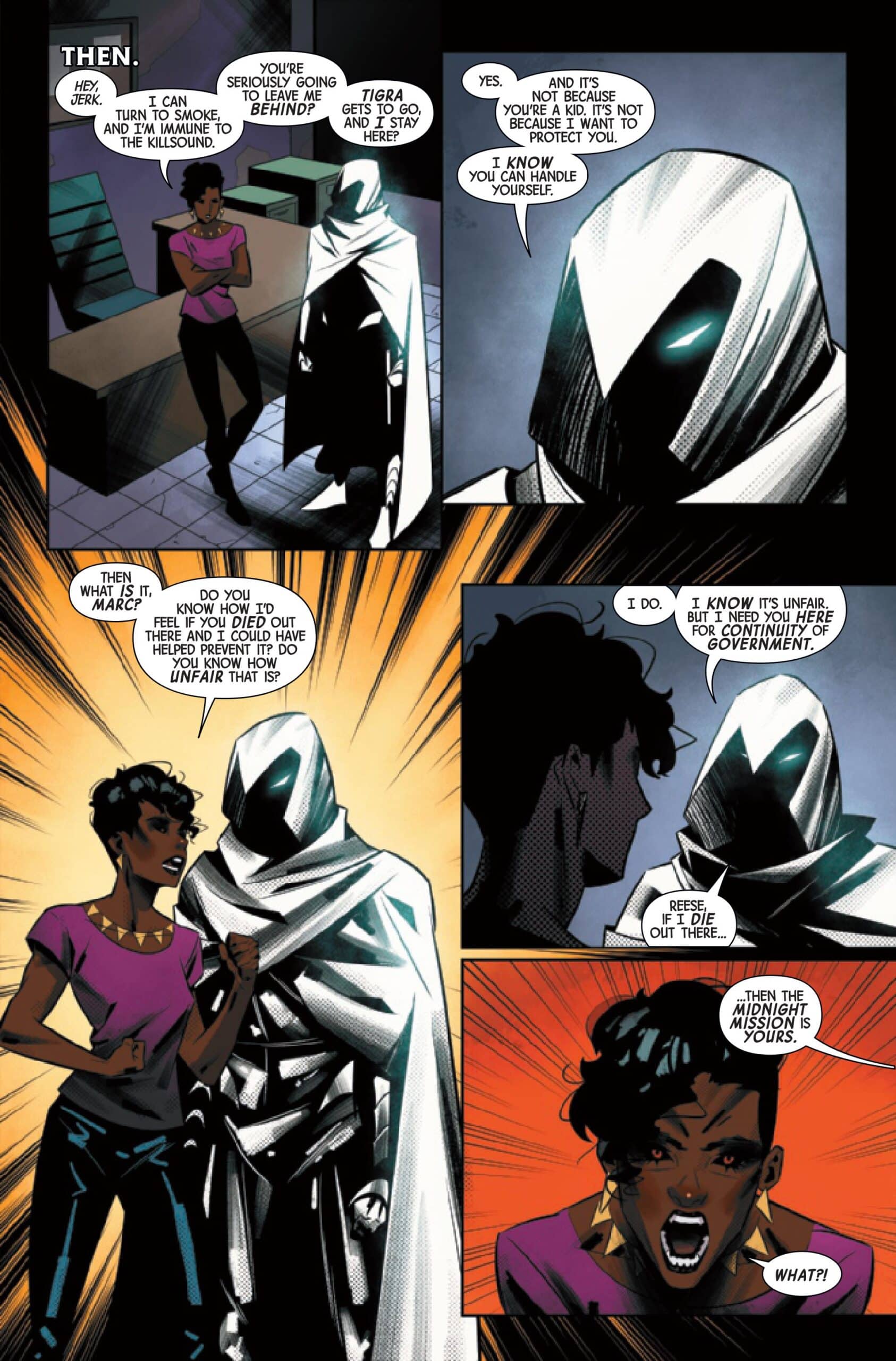Moon Knight #28

Recap
Moon Knight and his allies race to intercept the Black Spectre before his apocalyptic schemes bear fruit - but the clock is ticking, and a city hangs in the balance.
Review
The pivot to the limited and miniseries has been a boon for many in the comic industry, as it allowed for creators to cut the fat and tell, directed, cohesive stories. On the flip side, something was lost along the way, as creators no longer could experiment or play a long game as the finish line was always in sight. In the world of the shorter series, a book that has the time and permission to develop its supporting cast and seed a longer endgame is rare, and when they come along, one can’t but watch with the very least a passing interest.

Moon Knight #28 – written by Jed MacKay with art by Federico Sabbatini, colors by Rachelle Rosenberg, and letters from VC’s Cory Petit – launches the book into its endgame, as the titular vigilante and his comrades at the Midnight Mission stage their attack against Black Spectre. A crew made up of Moon Knight, Tigra, 8-Ball as the getaway driver, and Hunter’s Moon is a fascinating team dynamic. With Reese left behind as the inheritor of the Midnight Mission, both fronts are ready to face their respective villains.
The bulk of the issue is the team’s planning and then the siege of Black Spectre’s hideout. One by one, the team is taken out as they scale the tower until only Marc remains. Like any good Moon Knight story, the Fist of Khonshu is beaten and bloodied as he comes face to face with his villain, the duo’s fight looming for the next issue. On the other side of New York, the recently sprung Zodiac makes his move, seeking revenge on Moon Knight and his loved ones. It’s a fantastic twist that sets up the dueling villains of this climax, and possibly teases where the upcoming Vengeance of the Moon Knight might go.
MacKay’s scripting is immaculate in this issue, delivering page after page of all killer, no filler. Ranging from plotting to quiet emotional beats, and then an onslaught of killer action, the issue moves from one stage to another with no waste or fat. The balance of these three categories is essential to making this climax to the larger run work, and McKay thrives in the interweaving of all three elements. McKay executes the action with deft precision, moving from fight to fight that is equal parts engaging and in service of the characters/plot.

While the action is excellent, it’s the moments tying those beats together that make this installment sing. The tenderness of a budding romance between Marc and Tigra is the book’s emotional hook and adds a layer of foreboding to the later action. There’s a sense of calm before the storm, and allows for the characters (along with the reader) to take a deep breath before the high-octane action. It’s a testament to MacKay’s skill in playing the long game, building up these supporting cast members through the one-off stories of yesterday. Moon Knight’s chat with Reese and the passing of a legacy is another quiet beat that works as the gel that holds this issue together. The dynamic of Marc taking this changed woman under his wing and offering a path forward has been a simmering arc that feels wholly organic to the overall run.
MacKay does not deserve a singular sense of credit for this pitch-perfect walking of the tightrope, as Sabbatini’s artwork and Rosenberg’s coloring strike a similar balance. The issue’s linework plays in these moments of quiet enhancing the emotion by showcasing close-ups and the contortions of pained or conflicted expressions. Even interaction has a blend of tenderness and wistfulness, operating in the bittersweet to maximum effect. Sabbitini uses the space on the page to give each character their due, both in and out of costume, during and away from a fight.

The action of this story is just as compelling, and Sabbitini comes out swinging during the battle sequences. Earlier in the run, the division between mainstay artist Alessandro Cappuccio and Sabbitini was action and poses versus close-ups and emotional beats. Over the course of 30-something issues (counting annuals and tie-ins), that gap has closed and both artists have grown to show multifaceted approaches, remaining distinct as they borrowed elements from one another to create a blended aesthetic for the series.
That’s never more evident than in this issue’s action moments, with Sabbatini grasping for, and utilizing well the dynamic, almost abstract poses and postures for the book’s lead. There’s still a believable weight to the action scenes, as Moon Knight battles goon after goon. An eerie, supernatural adjacent feeling comes into the way the vigilante moves, dismantling his foes with practical ease. Sabbitini emphasizes this through the switched use of nine-panel grids and then splash page action moments. That progression from multiple panels, to a single page, and back creates a kinetic rhythm that feels closer to Cappuccio’s style, but Sabbitini makes his own here.


The great unifier of not only those two artistic styles, but the range of narrative modes is Rosenberg’s inspired coloring. This is a book that is constantly elevated by the palette employed, and it’s fantastic to see entering the endgame has changed nothing. Rosenberg’s hues in the quieter scenes evoke the bittersweet romantic longing between Marc and Tigra, and the subtle shifts in the background only enrich the moment of embrace. In the scene between Marc and Reese, the resentment of being left behind interjects a blood red that feels emblematic of the young woman’s status as a vampire.
The action beats are subsequently elevated as well thanks to those rich colors, the greens and yellows providing the perfect foundation for a fight between the spectral white of Moon Knight’s costume, and the consuming black of the Spectre’s horde of goons. It’s a smart way to create clarity in the sprawling action and is vital to the flow of the referenced nine-panel grid.
Final Thoughts
Moon Knight #28 is a pitch-perfect story for the character, taking the best elements of the run and elevating them thanks to heightened stakes and continued practice. MacKay begins to pay off the investment of characters over the last few years, as he allows the characters to thrive in their quiet moments before battle. Sabbatini’s art is at its apex, working in bits of Cappuccio’s style for a striking one-two punch of bittersweet emotion and cascading action. The coloring choices from Rosenberg work as the glue that binds the issue together and makes the final product strong on the page. This is an issue that rewards long-time readers while showing what is possible when a creative team is given the time and space to build up a run and tell a sweeping story that remains firmly planted in character.
Moon Knight #28: This Is Why We Fight
- Writing - 10/1010/10
- Storyline - 10/1010/10
- Art - 10/1010/10
- Color - 10/1010/10
- Cover Art - 10/1010/10





